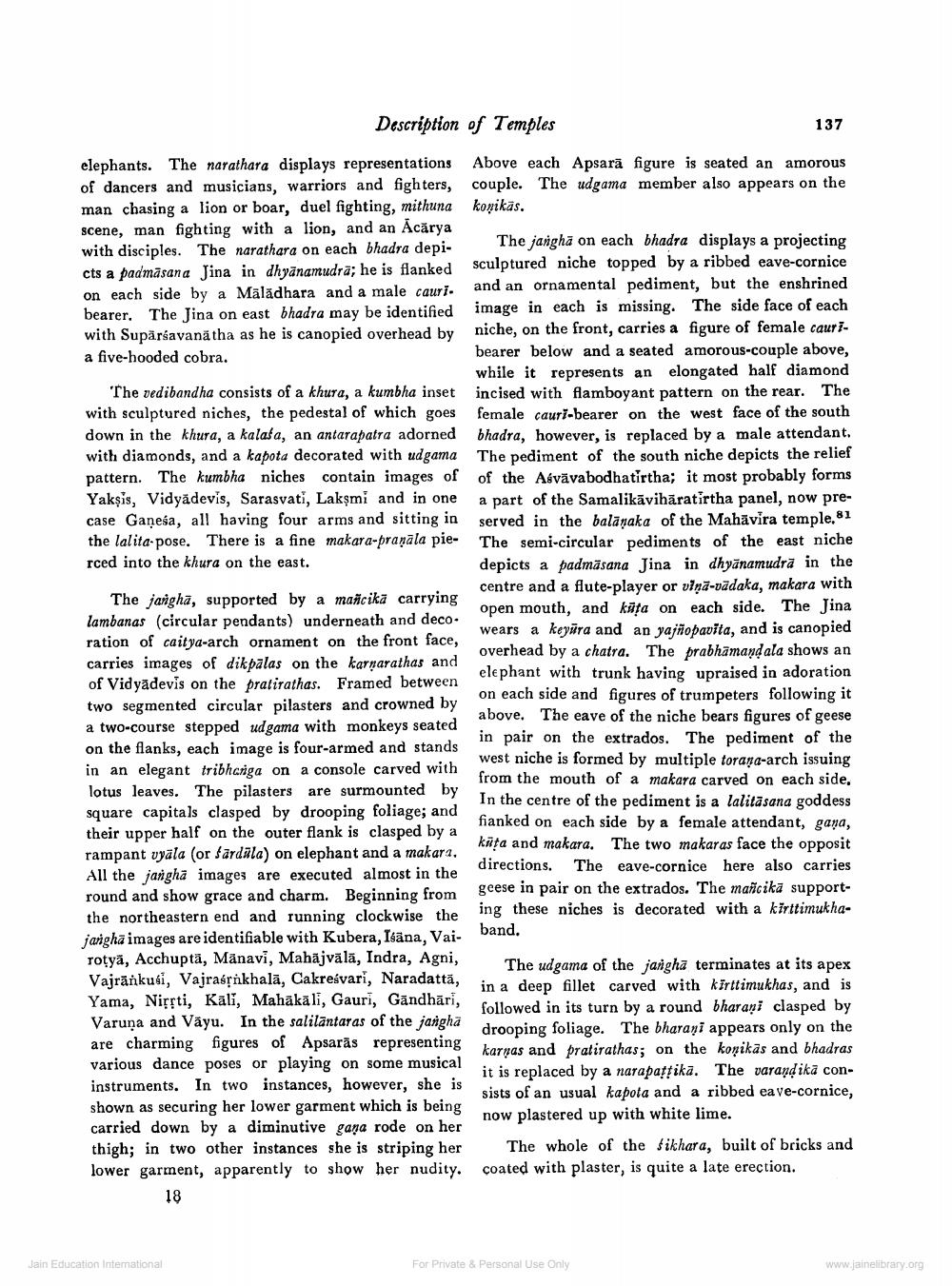________________
Description of Temples
137
elephants. The narathara displays representations Above each Apsarā figure is seated an amorous of dancers and musicians, warriors and fighters, couple. The udgama member also appears on the man chasing a lion or boar, duel fighting, mithuna konikas. scene, man fighting with a lion, and an Acārya with disciples. The narathara on each bhadra depi
The janghā on each bhadra displays a projecting cts a padmāsana Jina in dhyānamudra; he is flanked sculptured niche topped by a ribbed eave-cornice on each side by a Maladhara and a male cauri. and an ornamental pediment, but the enshrined bearer. The Tina on east bhadra may be identified image in each is missing. The side face of each with Supäršavanätha as he is canopied overhead by niche, on the front, carries a figure of female cauria five-hooded cobra.
bearer below and a seated amorous-couple above,
while it represents an elongated half diamond The vedibandha consists of a khura, a kumbha inset incised with flamboyant pattern on the rear. The with sculptured niches, the pedestal of which goes female cauri-bearer on the west face of the south down in the khura, a kalata, an antarapatra adorned bhadra, however, is replaced by a male attendant. with diamonds, and a kapota decorated with udgama The pediment of the south niche depicts the relief pattern. The kumbha niches contain images of of the Asvävabodhatirtha; it most probably forms Yaksis, Vidyadevis, Sarasvati, Lakşmi and in one a part of the Samalikāvihāratirtha panel, now precase Ganesa, all having four arms and sitting in served in the balanaka of the Mahāvira temple. the lalita-pose. There is a fine makara-praņāla pie- The semi-circular pediments of the east niche rced into the khura on the east.
depicts a padmāsana Jina in dhyānamudra in the
centre and a flute-player or viņā-vadaka, makara with The jangha, supported by a mañcika carrying
open mouth, and kāta on each side. The Jina lambanas (circular pendants) underneath and deco
wears a keyüra and an yajñopavita, and is canopied ration of caitya-arch ornament on the front face,
overhead by a chatra. The prabhamandala shows an carries images of dikpalas on the karnarathas and of Vidyadevis on the pratirathas. Framed between
elephant with trunk having upraised in adoration
on each side and figures of trumpeters following it two segmented circular pilasters and crowned by a two-course stepped udgama with monkeys seated
above. The eave of the niche bears figures of geese on the flanks, each image is four-armed and stands
in pair on the extrados. The pediment of the in an elegant tribhriga on a console carved with
west niche is formed by multiple torana-arch issuing
from the mouth of a makara carved on each side. lotus leaves. The pilasters are surmounted by square capitals clasped by drooping foliage; and
In the centre of the pediment is a lalitāsana goddess their upper half on the outer flank is clasped by a
fianked on each side by a female attendant, gana, rampant vyala (or fardala) on elephant and a makara.
kata and makara. The two makaras face the opposit All the jangha images are executed almost in the
directions. The eave-cornice here also carries round and show grace and charm. Beginning from
geese in pair on the extrados. The mañcika supportthe northeastern end and running clockwise the
ing these niches is decorated with a kirttimukha. jarigha images are identifiable with Kubera, Isāna, Vai- band. rotyä, Acchuptā, Mānavi, Mahājvālā, Indra, Agni,
The ud gama of the jargha terminates at its apex Vajrāńkusi, Vajrasțnkhala, Cakreśvari, Naradattă,
in a deep fillet carved with kirttimukhas, and is Yama, Nițrti, Kali, Mahākāli, Gauri, Gāndhāri,
followed in its turn by a round bharani clasped by Varuņa and Vāyu. In the salilantaras of the jangha
drooping foliage. The bharaṇi appears only on the are charming figures of Apsarās representing
karyas and pratirathas; on the koņikās and bhadras
karane ar various dance poses or playing on some musical
it is replaced by a narapattika. The varandika coninstruments. In two instances, however, she is
sists of an usual kapota and a ribbed eave-cornice, shown as securing her lower garment which is being
now plastered up with white lime. carried down by a diminutive gana rode on her thigh; in two other instances she is striping her
The whole of the Sikhara, built of bricks and lower garment, apparently to show her nudity. coated with plaster, is quite a late erection.
18
Jain Education International
For Private & Personal use only
www.jainelibrary.org




